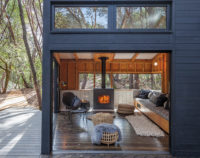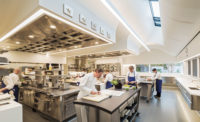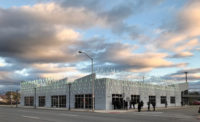German beer halls, which occupy spaces ranging from dark cellars to temporary tents, don’t necessarily depend on architecture to foster gemütlichkeit—a sense of camaraderie. But San Francisco’s latest version, Radhaus (the third Bavarian-style restaurant in the city from twin restaurateurs Aaron and Matt Hulme), notably relies on its materiality and waterfront views to enhance the experience of dining on Wiener schnitzel, bierwurst, and nine types of Bavarian draft beer.
Additional Content:
Jump to credits & specifications
“It’s in keeping with German beer halls that are big, beautiful spaces where the whole town comes together,” says Douglas Burnham, a principal of Berkeley-based Envelope A+D, which designed Radhaus. “There’s a grandeur to these places.”
The welcoming 125-seat eatery sits in a steel-truss and concrete block warehouse that features a 28-foot-high ceiling and 1,350 square feet of steel-sash windows overlooking a marina and the Golden Gate Bridge. (Some windows were bricked over and had to be restored to give back the space’s abundant views and light.) Recently, the Fort Mason Center, a nonprofit that manages the larger Fort Mason Historic District, which is a former military port on the city’s northern waterfront, moved its offices out of the 3,850-square-foot building to bring in a hospitality tenant that would help make it a destination, like residents of other revitalized landmarks nearby. Radhaus’s walls once contained a 1934 naval machine shop. That history and a mix of programming brought in by neighbors such as the San Francisco Art Institute make the location ideal for Envelope A+D’s fresh take on a traditional beer hall, render it inviting to a new generation.
To transform the historic structure into a bustling restaurant, the architects first restored its impressive open bay, which the previous tenant had divided with interior walls. That cleared the way for the firm’s main move: building a 1,300-square-foot, two-tiered mezzanine block at the center of the floor, with offices and dry storage on one level, and mechanicals for the busy nine-person kitchen on the other. A new mat-slab foundation supports the weight of these neatly enclosed mezzanine spaces and the open kitchen created in the area beneath them. The building-within-a-building is the team’s solution to historical-preservation guidelines, which prohibited placing anything on the red-tile roof, including necessary new mechanical systems. Supply air enters the mezzanine through a small amount of exposed ductwork, and concealed fans pump conditioned air out through porthole-shaped vents. The architects painted the mezzanine, its support columns, walls, and ceiling white, including the steel trusses, pipes, ductwork, and an indoor crane left over from the space’s industrial days, to enhance a sense of voluminous space.
To complement the grandeur of the views and the ceiling height, the design team wanted some furnishings to have their own monumentality. To that end, they worked with Evan Shively at Arborica, who salvaged two 300-year-old Ponderosa pines and milled them into the restaurant’s signature elements—a 30-foot-long bar and a massive bench that provides communal seating (a staple of traditional beer halls). The standing bar, counter seating, and simple wooden-slat folding chairs and tables, add to the hall’s informality. “It’s a hardworking space, but we wanted it to seem effortless,” says Burnham.
CreditsArchitect: envelope A+D, 2212 Sixth Street, Berkeley, CA 94710,+1 510.644.2400, envelopeAD.com
Personnel in architect's firm who should receive special credit: Douglas Burnham, principal/founder & Lex Phelan, architect/associate partner
Architect of record: envelope A+D, 2212 Sixth Street, Berkeley, CA 94710,+1 510.644.2400, envelopeAD.com
Interior designer: envelope A+D, 2212 Sixth Street, Berkeley, CA 94710,+1 510.644.2400, envelopeAD.com
Engineers: MEP: MHC Engineers, Inc. Structural: Mosswood Engineering Geotechnical: Romig Engineers, Inc.
Consultants: Wood Sourcing and Fabrication: Evan Shively of Arborica Wood Finishing: Gregory Hay Fine Furnishings Specialty Tile Layer (DTILE): J P Ziller Tile
General contractor: ACI General Contractors
Photographer: Matthew Millman Photography |
SpecificationsExterior Cladding Other cladding unique to this project: N/A (within existing historic building)
Roofing Other: N/A (within existing historic building, roofing is clay tile)
Windows Metal frame: Century 2000 Series Custom Steel Pivot Doors: Torrance Steel Window Co., Inc.
Glazing Glass: Salvaged historic wire glass / clear glass panes
Doors Entrances: Century 2000 Series Custom Steel Pivot Doors: Torrance Steel Window Co., Inc. Metal doors: Falcon SZ Series Flush Doors: Steelcraft
Hardware Closers: BTS80 Floor Closer: Dorma
Interior Finishes Cabinetwork and custom woodwork: Massive Log Bar and Seating Elements: Sourced and Fabricated by Evan Shively at Arborica, Finished by Gregory Hay Fine Furnishings Floor and wall tile: Modern Wall Tile: Daltile; Suretread Diamond Plate Floor Tile: Daltile Special interior finishes unique to this project: DTILE: Droog Design (functional tile system covering the back bar refrigerated keg storage, beer taps and glassware storage element)
Furnishings Other furniture: Massive Log Bar and Seating Elements: Sourced and Fabricated by Evan Shively at Arborica, Finished by Gregory Hay Fine Furnishings (also listed under ‘Interior Finishes’ above)
Lighting Interior ambient lighting: Salvaged Light Fixtures: supplied by Artefact Design & Salvage Downlights: RA56 LED Adjustable Gimbal downlights: HALO Tasklighting: MT-4LD2 LED Retractable, adjustable spot lights: WAC Lighting
Plumbing AFWALL Millenium FloWise 1.6/1.1 GPF Dual Flush Toilet: American Standard Steward Waterless Urinal: Kohler Modulating Ultra Force Condensing Water Heater: State Water Heaters
Energy Energy management or building automation system: Vari-Flow Controls: Greenheck |










Post a comment to this article
Report Abusive Comment